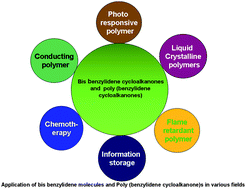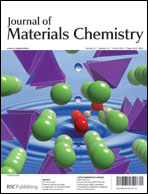Bisbenzylidene cycloalkanone: a versatile molecule as a polymer building block
Abstract
Bisbenzylidene cycloalkanone [BBCA], a versatile photo-active molecule, has already shown its potential for applications in biology, chemistry, materials science and technology. The molecule possesses the dual nature of a photo-active molecule and a mesogenic unit. It was studied as such for medical applications and by incorporating it into polymer architectures for harnessing its properties as a photo-active as well as a mesogenic unit. It was incorporated into almost all kinds of polymer architectures from polyester to polyimide. The special features of the polymer bearing this unit are high thermal stability, photo-curing ability (for adhesives, photo-resists, holography), electronic conductivity, fluorescence, etc. Even during the past decades progress was made mostly in the methods of synthesis and structural understanding of these polymers, the functional understanding and application of these polymers are still in their infancy. Quite recently, bisbenzylidene cycloalkanone polymers (linear and hyperbranched) have been reported by our group. The hyperbranched polymers address some problems regarding the solubility and quick photo-response of bisbenzylidene polymers. We discuss the state-of-the-art of this multi-disciplinary BBCA molecule and BBCA containing polymers reported to date. We believe this article will be very useful as the progress in science and technology concerning this molecule is rather slow. Our aim is to bring together details of the work reported so-far and its significance that will be useful to the scientific community.


 Please wait while we load your content...
Please wait while we load your content...